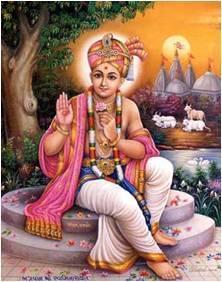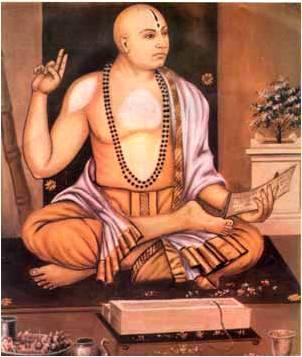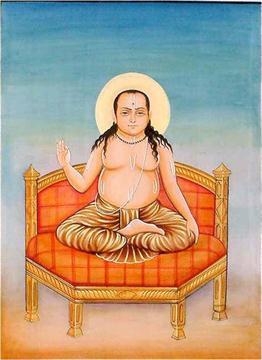VAISHNAVA SAMPRADAYA
Contents
. Introduction
. The Sri Devi or Lakshmi Sampradaya
. Shri Ramanujacharya
. Swaminarayan Sampradaya
. Brahma Sampradaya
. Madhvacharya
. Gaudiya Sampradaya
. Chaitanya Mahaprabhu
. Rudra Sampradaya
. Vallabhacharya
. Nimbarka Sampradaya
. Nimbarkacharya
. Conclusion
Introduction
Vaishnavites are followers of Lord Vishnu (or his ten incarnations). The name Vishnu means one who pervades everything or the omnipresent one. He is the all pervading one, one who encompasses the entire creation, who is beyond time, who sustains, preserves and nourishes the entire universe. He cannot be persevered by intellect or logic. He is omnipresent, omnipotent and omniscient. He is beyond time, space and intellect. He is the Supreme Lord, the Matchless One, the One without a Second.
The followers of Vishnu are called Vaishnavites. They are given initiation into a mantra by a Guru who trains them on the principles and beliefs of Vaishnavite dharma. He is encouraged to continue the chanting of the mantra till it becomes a continuous flow.
There are four Vaishnava Sampradayas, each Sampradaya has slight subtle differences among them though the core essence of the teachings is the same.
They are-1) Sri Sampradaya
2) Brahma Sampradaya
3) Rudra Sampradaya
4) Nimbarka Sampradaya
Vaishnava Sampradaya

Thus a Vaishnava should study the commentaries written by the heads of these four branches, fully assimilating the import of the essence of their teachings. A detailed study of each of these branches is essential to understand the deep significance of this Sampradaya.
1) The Sri Devi or Lakshmi Sampradaya
This is believed to have been born with the consent of Lakshmi, the consort of Lord Vishnu. She is supposed to act as the mediator between the Lord and the devotee. She helps the devotee in seeking refuge at the Lotus feet of the Lord thereby liberating him from the cycle of birth and death. She binds the devotee, the Lord and the Guru together in devotion. She brings about the philosophy of non duality or Vishishta Advaitha.
The philosophy behind this Sampradaya is that there exists a Supreme Being, an Ultimate God head who is the source and substratum of this entire universe and of all that exists. This Supreme entity is the core of all creation. Communion with this being is the true meaning of all existence and this can be achieved through devotion, unconditional surrender and meditation. This Sampradaya involves a vibrant temple culture, the illuminating insights of the Acharyas, the discourses of the sages and the deep devotion and love of the Alwar saints for the Lord in rich poetic form.
Shri Ramanujacharya

Shri Ramanuja was a philosopher from Tamil Nadu as well as a social reformer whose life and works show a unique personality, an exalted soul whose dynamism and selfless dedication to God made him one of the most important and charismatic personalities of Ancient India in particular of Sri Vaishnavism.
He was considered to be an incarnation of Adi Sesha, the coiled serpent of Lord Vishnu.
Sri Ramanuja was born at a time when Shankara’s advaita philosophy and the Brahmins propagating Vedas and other religious texts were predominant. This quality of an impersonal God could not be comprehended by many and a need was felt for a more personalized and loving form of God. Thus was born the Sri Sampradaya. It took the shape of the mystical and passionate forms of the Bhakti movement.
There are a number of instances quoted wherein during public debates as were held in those days between scholars of various repute, Ramanuja always wanted to understand and interpret the Upanishadic verses in a more devotional way rather than accepting the stark and intellectual interpretation of his adversaries.
Ramanuja vowed to undertake three most important tasks-
1) He would take up the Vaishnava faith and uplift humanity by teaching them about unconditional surrender to the Divine Lord.
2) He would compile a commentary on the Vedanta Sutras by collecting all the teachings of the Vedas and other Gurus.
3) He would perpetuate the name of Parasara Muni who is supposed to be the author of Vishnu Puran
His main goal was to give the concept of a personal deity with a personal identity whom people could relate to and increase devotion irrespective of the caste, creed and gender of the people. This was easy for the masses to relate to as opposed to the non dualistic interpretation of Vedanta and philosophical commentaries of Shankara’s Advaita which could only be understood by the erudite and intellectual class of society.
He wrote the commentary on the Brahma Sutras known as the Sri Bhashya. He wrote three other books –Vedanta Sara (essence of Vedanta), Vedanta Sangraha (a summary of Vedanta) and Vedanta Deepa (the light of Vedanta).
Ramanuja’s concept of Brahman was qualified non dualism, ie- a Brahman with attributes. According to him, Lord Vishnu is the Supreme Being, the jiva or the individual soul is the worshipper. The jiva should completely surrender to the Lord.
Ramanuja is also hailed as a social reformer as he treated all people alike and in the rigid caste based society of Ancient India he was a beacon of hope especially to the lower classes. He emphatically stated that no person can be categorized on the basis of their birth and every human being had only one goal in life and that was surrender and merging in the Lotus feet of Lord Vishnu through love, devotion and onepointedness. He extolled that living entities were quantitatively different but were qualitatively one with the Divine. The Advaitic Philosophy that everything was Brahman and individuality arose only due to Maya was staunchly opposed by Ramanuja. His philosophy was that one could never know an unqualified object. When living entities are freed from illusion of this material world through devotion and surrender to Lord Vishnu, then the soul enters Vaikuntha and there it engages in eternal service to Lord Vishnu, the Supreme Being.
He urged people to extol Narayana, sing his glories, chant His Divine Names serving others and removing the evil qualities of lust, anger and greed. With sincerity, love and devotion to the Lord they would attain the Supreme Godhead Lord Vishnu.
According to him, there were three classes of souls, the Nithya(eternal), Mukta(free) and Baddha(bound). The eternal souls are said to be living with the Lord in Vaikuntha and were never bound. The Mukta was at one stage in Samsara but has now attained salvation and lives with the Lord. The bound souls are caught in the web of birth and death and wander from life to life till they are redeemed. Each individual is like a seed while Lord Vishnu is the entire fruit. Once they are redeemed they never become identical with the Lord but live in fellowship with Him, meditating on Him and serving him which can only happen through devotion, surrender and the descent of the Lord’s grace.
Other prominent leaders of the Sri Sampradaya were the Alwars who were the mystic poet saints of Tamil Nadu. Their songs influenced and shaped Vishishtadhwaita. The vision of a personal divinity worshipped with great love and devotion irrespective of caste, creed and gender was at the hallmark of the Vaishnava Sampradaya which the Alwars exemplified. Their songs were all songs of love, devotion and longing for lord Vishnu and his various Avatars. The Bhakthi movement of the Sri Sampradaya was greatly influenced by the alwars. They made supreme knowledge accessible to the common man especially those who did not have sufficient knowledge of Sanskrit or who was denied his birthright as he was born in a lower caste as was prevalent in the caste system at that time.
Thus this Sampradaya considers God as love and religion as the life of God in the love of man.
Swaminarayan Sampradaya

This Sampradaya was established by Lord Swaminarayan to propagate the teachings and philosophy of Vishishtadvaitha. He is considered to be an incarnation of Lord Vishnu who came down to earth to alleviate the sufferings of mankind and set him on the path of devotion and renunciation.
Followers of the faith are called Satsangis and they have to follow certain basic rules laid down by Swaminarayan. It has its roots in the Vedas. It focuses on salvation through total devotion to God through dharma, jnana and vairagya ie virtue, knowledge and detachment. The organization believes that irrespective of caste or creed the devotee should begin the day with pooja or prayer, do one’s work sincerely and help in serving society. A number of temples which are famous for its remarkable architecture have been constructed to instill devotion in the minds of the people. These temples have become centres of worship, studying holy texts, devotional music and centres of social service where alms, medicines and clothes are provided to the poor and the needy.
The Acharyas or Gurus of this Sampradaya initiate followers by giving the guru mantra, initiate monks by giving the Maha Bhagwadi diksha, install deities in temples, authenticate scriptures of the Sampraday and act as leaders of the entire Sampraday.
There are eight important things in the life of a follower or satsangi, Kanthi- a thread worn around the neck, Tilak Chandlo-holy mark, Mala- a thread with 108 beads, Nitya pooja- daily prayers, Mandir – temple, darshan- worship of the Lord, Aarti- waving of lamps around the Lord, Vandu Pad and Chesta Pad-verses recited in the temples daily.
Lord Swaminarayan is said to have initiated 500 Paramahansas or realized souls who have been carrying on the tradition through generations.
2) Brahma Sampradaya.
Brahma Sampradaya is the succession of Gurus starting with Brahma as its founder. It is believed that knowledge of the Vedas descends from Brahma. They are supposed to have begun at the creation of the universe and are transmitted to each successive Guru so that they exist in the present moment of a student in the same pure state through all generations as it was in the beginning of time.
Madhvacharya

Madhvacharya who was born in Karnataka propagated the Dvaitha or dualistic school of philosophy. He was one of the most important philosophers of the Bhakti movement. He is considered to be the third incarnation of Vayu, the first two being Hanuman and Bhima. He was also called Ananda Tirtha.
In the Dvaitha School of philosophy, Vishnu is considered as the Supreme Lord. There are three distinct entities, God, soul and inanimate nature. God was Sat-Chit-Ananda ie Sat meaning Truth, Existence or pure being, Chit meaning consciousness and Ananda meaning bliss. He was the epitome of all perfection. The individual souls exist as small entities due to the grace of the Lord. Madhva’s philosophy was called Tatva Vada or the philosophy of reality.
He was dissatisfied with the Advaitha Vedanta philosophy of Shankara. He felt God was a more personal Being and with love and devotion irrespective of caste and creed every human being could attain him. He preached that Krushn who is one of the incarnations of Lord Vishnu was the Absolute and Supreme Lord of the universe. He stated that atman and Brahman were two distinct entities. He identifies Brahman with Vishnu but states that the atman cannot be identified with the Brahman and Vishnu is supreme on the basis of his attributes. He believed in a hierarchy of jivas based on their gunas and doshas.
The Gaudiya Sampradaya
The focus of this Sampradaya was Lord Krushn who is one of the incarnations of Lord Vishnu. Followers of this Sampradaya believed in Dvaita philosophy and traced its divine origins to Brahma. The ultimate aim of the Jiva is Bhakthi or pure unalloyed love for the Lord. According to them Krushn was the all pervading being who was Sat-Chit-Ananda and he was omniscient, omnipresent and omnipotent. Krushn is the energy sustaining the universe, and practice of Bhakti yoga would lead to moksha or liberation from the cycle of birth and death.
Chaitanya Mahaprabhu

The life of Shri Chaitanya Mahaprabhu is one of the most inspiring and exalted forms of Bhakti Yoga or supreme love and devotion to the divine. He was born in Bengal and he worshipped the forms of Krishna. According to him, the chanting of the Hare Krushn maha mantra irrespective of class, creed, gender and knowledge was the sure way to attain the Lord’s feet in this Kali Yuga.
According to him Krushn was the essence of all beings, human beings were bound to the cycle of birth and death by their karmas and love and surrender to Krushn would result in unalloyed bliss. His philosophy was called the Gaudiya Sampradaya. Though he was initiated in the Vaishnava tradition of Madhvacharya, there were some marked differences with the practices making it a distinct Sampradaya on its own. It was in this tradition that the ISKCON movement was started propagating Chaitanya Mahaprabhu’s teachings.
He is considered to be an incarnation of Lord Krushn, identifying himself to be Radharani while praising and singing the glories of the Lord. His followers follow the Gaudiya Vaishvanism form of Bhakti.
Chaitanya Mahaprabhu preached Vaishnavism and it was called the Gaudiya sampradaya. He believed that chanting the divine name of Krushna could purify the heart and cleanse it of all impurities.
3)Rudra Sampradaya
The origins of this Sampradaya has been traced to Rudra(Shiva). According to this, knowledge has been passed on to Shiva by Vishnu to be passed on to mankind.
Vallabhacharya

Vallabhacharya was a philosopher from Andhra Pradesh who was associated with Vishnuswami who was a prominent Acharya of the Rudra Sampradaya. He is considered to be an avatar of Agni. He followed the path of pure non dualism or Shudha Advaitha and he founded the Pushti sect in India. He preached that since everything was created by a Pure Being Krushn, everything including the material universe was pure. The realization of Brahman was only through Pushti(nourishment) that means total surrender to God. Krushn was the highest Brahman, He was Sat – Chit –Ananda. He preached the Vatsalya bhava of Bala Krushn.
The Pushti Marg propagated by him was the path of divine grace. It is based on pure love for Lord Krushn. This love should be unsullied and lead to seva of the Lord. It is not based on caste, creed or gender. They can be householder disciples and there is no compulsion to attain monkhood. Desires need not be suppressed but they must be channelized towards love and devotion to Lord Krushn. Attaining Krushn’s bliss is the goal and not liberation. Since the entire universe is Lord Krushn’s creation it is not considered to be unreal. Love of God was an end to itself and not a means to an end. There is no difference between the creator and the created. All are pure and perfect. Different forms of seva are performed to the Lord like singing, offering Prasad, decorating the deity etc. Important events in Krushn’s life are celebrated with great fanfare, all this to increase love and devotion for the Lord.
4)Nimbarka Sampradaya
This Sampradaya was considered to be founded by the four Kumaras who were the mind born sons of Lord Brahma, namely Sanandana, Sanaka, Sanatana and Sanat Kumara. They were chosen by their father to perpetuate creation but they undertook vows of Brahmacharya(celibacy) and got a boon from their father to remain perennially 5 years old.They obtained the grace of Lord Krushn and began to spread the teachings of Vaishnavism. The Sage Narada was their disciple who was also their younger brother and the son of Brahma. Sage Narada then initiated Nimbarka into Vaishnavism and the worship of the divine couple Radha –Krushn.
This Sampradaya was also called Hamsa sampradaya because the first Guru was considered to be Hamsa Bhagawan or the swan incarnation of Radha-Krushn.
Nimbarkacharya

Nimbarkacharya was born in Andhra Pradesh. He was considered to be the incarnation of the Sudharshan Chakra of Krushn. He reconciled all the schools of thought of the other three acharyas, namely Ramanuja, Madhva and Vallabha. His philosophy was the Dvaitadvaitha which means existence of duality and non duality at the same time. He gave the example of waves in an ocean and illustrated that though the waves exist because of the ocean, they are distinct, different entities. Thus Jiva and Prakriti or nature are different entities but they have the essence of Brahman in them. God as Radha-Krushn is the Supreme Being. Devotion with unconditional surrender or prapatti is the final goal of life. Attachment to the senses, body and mind is the cause for karma and rebirth and Bhakti along with grace of the Lord is the only release from this bondage. This could be attained with the fivefold path of ritual action(karma), knowledge(vidya), meditation(dhyana), devotion(bhakti) and surrender(prapatti).The basis of this Sampradaya is service to the Lord Radha-Krushn like bathing, decorating the idol, preparing food and then partaking it as prasada. Thus, this could be practiced by all irrespective of caste, creed, gender or intellectual proficiency.
Conclusion
The propagation of these Sampradayas in the Guru-Shishya Parampara enables to maintain the purity and essence as divined upon by its founders. Thus we have non duality with specific attributes(Vishishtadvaita) by Ramanujacharya, pure duality(Suddha dvaita) by Madhvacharya, pure non duality(suddha advaitha) by Vallabhacharya and oneness and difference (dvaitadvaita) by Nimbarka Swami.
